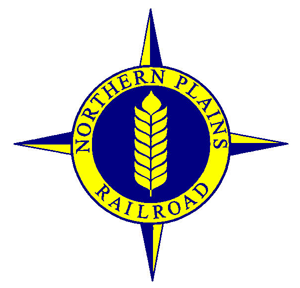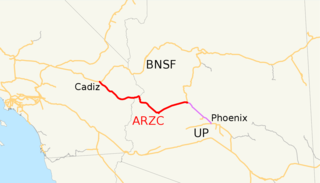Related Research Articles

Cicero is a suburb of Chicago and an incorporated town in Cook County, Illinois, United States. Per the 2020 census, the population was 85,268. making it the 11th largest municipality in Illinois. The town of Cicero is named after Marcus Tullius Cicero, a Roman statesman and orator.

BNSF Railway is one of the largest freight railroads in North America. One of seven North American Class I railroads, BNSF has 35,000 employees, 32,500 miles (52,300 km) of track in 28 states, and nearly 8,000 locomotives. It has three transcontinental routes that provide rail connections between the western and eastern United States. BNSF trains traveled over 169 million miles in 2010, more than any other North American railroad.

The Belt Railway Company of Chicago, headquartered in Bedford Park, IL, is the largest switching terminal railroad in the United States. It is co-owned by six Class I railroads — BNSF Railway, Canadian National Railway, Canadian Pacific Railway, CSX Transportation, Norfolk Southern Railway, and Union Pacific Railroad — each of which uses the switching and interchange facilities of the BRC. Owner lines and other railroads bring their trains to the Belt Railway to be separated, classified, and re-blocked into new trains for departure. The BRC also provides rail terminal services to approximately 100 local manufacturing industries. The company employs about 440 people, including its own police force.

The Alabama and Tennessee River Railway is a shortline railway operating over trackage formerly operated by CSX Transportation. The line's western terminus is a junction with the CSX main line in Birmingham, Alabama, near CSX's Boyles Yard. The eastern terminus is Guntersville, Alabama, near the Tennessee River. The parent company of the ATN is OmniTRAX, a major operator of American and Canadian short lines.
The Chicago Rail Link is a shortline switching railroad in Illinois. It owns and operates more than 72 miles of track on the South Side of Chicago. It is owned by OmniTRAX.
Established in 1908, the Stockton Terminal and Eastern Railroad provides service to several companies around the Stockton area, in San Joaquin County, California.
OmniTRAX, Inc. is a transportation and transportation infrastructure holding company based in Denver, Colorado, in the United States. It primarily owns or operates railroads, with a network of 25 regional and shortline railroads in 12 U.S. states and three Canadian provinces. It is one of the largest privately owned railroad companies in the United States. The firm also invests in, develops, and operates ports, multimodal transportation terminals, and industrial parks.

The Northern Plains Railroad is a short line railroad that operates over 344 miles (554 km) of track in the northern U.S. state of Minnesota and the northern U.S. state of North Dakota.
Cermak Road, also known as 22nd Street, is a 19-mile, major east–west street on Chicago's near south and west sides and the city's western suburbs. In Chicago's street numbering system, Cermak is 2200 south, or twenty-two blocks south of the baseline of Madison Street. Normally, one mile comprises eight Chicago blocks, but the arterial streets Roosevelt Road, formerly named Twelfth Street and at 1200 South, and Cermak Road were platted before the eight-blocks-per-mile plan was implemented. Roosevelt Road is one mile south of Madison Avenue and there are twelve blocks within that mile. Cermak Road is two miles south of Madison Avenue and there are ten blocks within the mile between Roosevelt and Cermak Roads.

The Burlington Junction Railway is a Class III short line railroad which was chartered in 1985. Originally operating on the southernmost 3 miles (4.8 km) of the former Burlington, Cedar Rapids and Northern Railway mainline in Burlington, Iowa after abandonment by the Chicago, Rock Island and Pacific Railroad, it provides short freight hauling, switching operations, locomotive repair, and transloading services, the latter currently handling over 3,000 carloads a year. Typical commodity types transported include chemicals and fertilizer. The BJRY's primary interchange partner is the BNSF Railway.

The Hawthorne Works was a large factory complex of the Western Electric Company in Cicero, Illinois. Named after the original name of the town, Hawthorne, it opened in 1905 and operated until 1983. At its peak of operations, Hawthorne employed 45,000 workers, producing large quantities of telephone equipment, but also a wide variety of consumer products.
The Kettle Falls International Railway is a shortline railroad in the U.S. state of Washington and the Canadian province of British Columbia. This OmniTRAX subsidiary operates 44 miles (71 km) of track.
The Nebraska Northwestern Railroad is a Class III railroad that began operations in April 2010 after it purchased 7.22 miles (11.62 km) of former Dakota, Minnesota and Eastern, now Rapid City, Pierre and Eastern Railroad, previously Chicago and North Western Railway Cowboy Line track between Dakota Junction and the rail yard at Chadron, Nebraska. In addition to the 7.22 miles of owned track, the railroad leased the line between the connection with the DME Rapid City line at Dakota Junction and the connection with BNSF Railway at Crawford, Nebraska.
The Grand Forks Railway is a shortline railway company operating in the West Kootenay region of southeastern British Columbia.

The Arizona and California Railroad is a class III short line railroad that was a subdivision of the Atchison, Topeka and Santa Fe Railway (ATSF). The ARZC began operations on May 9, 1991, when David Parkinson of the ParkSierra RailGroup purchased the line from the Santa Fe Railway. ParkSierra Railgroup was purchased in January 2002 by shortline railroad holding company RailAmerica. The Genesee & Wyoming shortline railroad holding company purchased RailAmerica in December 2012. ARZC's main commodities are petroleum gas, steel, and lumber; the railroad hauls around 12,000 carloads per year.
Barstow Yard is a classification yard operated by Burlington Northern Santa Fe Railway (BNSF) in Barstow, California. With 48 directional tracks and a total area of approximately 600 acres (240 ha), it is the second largest classification yard west of the Rocky Mountains after the JR Davis Yard. Today, almost all freight traffic to and from Southern California runs through the junction.

The Illinois Northern Railroad was an industrial switching railroad serving Chicago's southwest side. From their yard at 26th St. and Western Ave. the line went southwest to the Santa Fe Railway's Corwith Yard, connecting with most major area railroads and serving on-line customers on the way. They also leased and switched track east of their yard. Incorporated in 1901, it was merged into the Santa Fe Railway in 1975.
The Chicago and Illinois Western Railroad was an industrial switching railroad serving the west side of Chicago and southwest Cook County. From a connection with a now defunct north–south railroad line near 31st Blvd. and Western Ave. it went west along 33rd St. to Cicero. Just before Cicero Ave. it turned south and roughly paralleled Cicero Ave. to the Chicago Sanitary and Ship Canal. At the canal it turned west and paralleled the canal and then the Des Plaines River to Hodgkins. Incorporated in 1903, it was merged into the Illinois Central Gulf Railroad in 1984. In 2020 a short segment is used by the Canadian National Railway and the Cicero Central Railroad.
References
- 1 2 Schlagheck, Dennis; Lantz, Catherine (2014). Hawthorne Works. Arcadia. p. 47. ISBN 9781439644812.
- 1 2 3 Lewis, Edward A. (1996). American Shortline Railway Guide. Kalmbach. p. 187. ISBN 0-89024-290-9.
- 1 2 The Official Railway Equipment Register. Railway Equipment and Publications Co. June 1917. p. 484. Retrieved January 15, 2022.
- ↑ "Tiny Railway has King Size Job in Cicero". Chicago Tribune. March 1, 1998.
- 1 2 "MJ Railway: The Little Train That Does". Chicago Tribune. August 21, 1958.
- ↑ Employer Status Determination, Manufacturers' Junction Railway, LLC (MJR) (PDF). US Railroad Retirement Board. February 8, 2018. Retrieved January 14, 2022.
- ↑ "Manufacturers' Junction Railway, LLC". OmniTRAX. 2022. Retrieved January 19, 2022.
- 1 2 Smoke Abatement and Electrification of railway terminals in Chicago. Rand McNally & Co. 1915. p. 352. Retrieved July 24, 2022.
- 1 2 Sanborn Fire Insurance Map from Chicago, Illinois. Sanborn Map. 1918. p. Vol. 20 Sheet 135.
- ↑ Sanborn Fire Insurance Map from Chicago, Illinois. Sanborn Map. 1918. p. Vol. 20 Sheet 136.
- ↑ "Viewing Album: Manufacturers Junction Railway". 2007. Retrieved 24 December 2022.